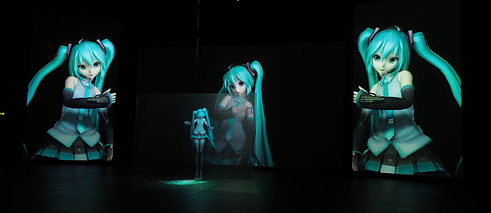CTM Festival 2016
Deep Listening

The CTM festival was founded in 1999 as an independent, musical complement to the media art exhibition “Transmediale”. In the meantime the Berlin festival has developed into one of the most important international venues for experimental sounds from pop to avant-garde. In 2016, the festival was entitled “New Geographies”.
Hatsune Miku is one of the biggest pop stars in Japan, with 100 million YouTube hits, numerous albums, stadium concerts and a repertoire of around 100,000 songs. At the Berlin CTM Festival you could experience her on two sold-out nights in the House of World Cultures. She rocked to hypermodern, watery-streaky electro-beats, a sixteen-year-old, blue-haired girl with a high, squeaky voice – among other manifestations. Because in an accompanying film you suddenly hear her in a deep, masculine timbre. She exists only as a holographic animation, born as an advertising character for a voice synthesizer, gender neutral, nowhere at home, eternally young, her human voice is a completely synthetic illusion.
Pop and Experiment
The subtitle of the CTM calls it a “Festival for Adventurous Music and Art”. The original delimitation to electronic music has long given way to an openness to every kind of musical vanguard. Since 2005 the festival also includes “applied arts” and supplies the context to each acute discussion in workshops and roundtables. Hatsune Miku’s appearance is almost an ideal-typical embodiment of the spirit of the CTM: Still Be Here, the title of the production, was realized by an international group of artists from digital art, film, performance and avant-garde pop – as soundtrack to a multi-layered, polyphonic audio-visual essay on the idiosyncratic landscapes of pop, market, bodies and collective longing.Beyond art-immanent projects like the Hatsune Miku production, the theme “New Geographies” was also inspired by current global conflicts and migrations. For example, the 83-year-old grande dame of American electronic music and inventor of “deep listening”, Pauline Oliveros, gave one of her three concerts for refugee assistance. Even more, the festival organizers wanted to show the richness and fruitfulness of trans-cultural processes. You hear, wrote Jan Rohlf, one of the festival founders, in his preface, a “global polyphony, which needs multiple perspectives”; and for this reason the festival, advised and co-curated by Berlin-Lebanese producer and label owner Rabih Beaini, laid particular emphasis on positions beyond the established spheres. Because sounds from Africa, Asia and South America, according to the thesis of the exhibition Seismographic Sounds, have long settled down, thanks to the internet and samples, in the formerly dominant pop cultures – which in turn they have generously appropriated.
Queer hip-hop, techno from the Congo
Thanks also to public funding and institutional support such as that of the Goethe-Institut, the festival today is one of the most prestigious of its kind in the world and now and again, as in September 2015, can export itself as CTM Siberia to Novosibirsk. In Berlin its success can be measured not least in the length of the lines: a young audience is interested in new club sounds such as the footwork-beats of the producer Jlin or the dazzling rap of Le1f, currently the most prominent exponent of queer hip-hop. Or in the toxic noises and brutal bass of Tara Transitory, who true to her name describes herself not only as a musical but also as an “identitary” nomad and dances like an electronic shaman amidst the audience. Or in a rather traditional avant-gardist such as the Romanian composer Iancu Dumitrescu, who conducts his Hyperion Ensemble and his microtonal spectral music in the brimful techno institution Berghain.In the HAU theatre (Hebbel am Ufer), there were DJ sets with Swedish-Congolese techno, obscure Thai pop and Arabic sounds, which the american musician Alan Bishop issues in Seattle on his label “Sublime Frequencies” while also playing in his Egyptian trio Dwarfs of East Agouza. The listener learned to distinguish, quite without previous education, between the traditional songs of the Lebanese Tarab veteran Karim Abdel Shaar and a performance of the Canadian-Lebanese music and visuals duo Jerusalem in My Heart. Wistful synthpop or harsh distorted noises sounded to images of old hotels, leafy trees and bombed-out skyscrapers; but in the vocal passages you saw the sweeping gestures and heard the vocal lines of Shaar.
Geographies as lifeworlds
It became clear that by “geographies” the festival organizers did not mean only actual movements across national or regional boundaries. It was just as much about lifeworlds – for example, the gay conquest of the homophobic hip-hop territory, or trance analogies such as those of the Javanese tradition and those of the 1960s, or the expressionist noise school of a Peter Brötzmann. Right at the opening, the composer Rabih Beaini staged the clash of two improvisational quartets, which he conducted simultaneously and manipulated using a mixing console – thus instigating a kind of puzzle compounded of free jazz freedom and electro-modernist rigour.“Identity doesn’t interest me”, declared, for example, Maurice Louca, an acclaimed Egyptian electronic music producer and member of the Dwarfs of East Agouza, at a panel discussion on the “New Voices in the Middle East”. His Egyptian sounds, he said, are not a contribution to national history; he is simply a modern composer who helps himself to the obvious and available material. And his colleague Alan Bishop said with a shrug that he wasn’t concerned about laying on archives: “I just want the world to hear these great, forgotten sounds”.
The common motive of most of the festival artists was to evade definition. The oppositions of avant-garde and pop, mainstream and underground, lost their significance in the globally distributed nischedom. In the end there stand free-floating forms and characters like Hatsune Miku, which can represent different positions anywhere, unchanged in all eternity, yet always different.